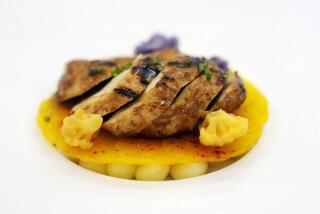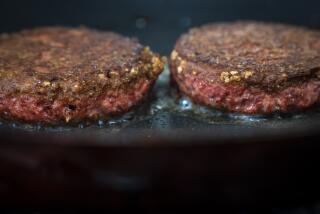Hormel Prospers by Getting Into Processed Food Lines : Keyword: Its profit has tripled since 1980, as it has reduced its emphasis on fresh meat products.
- Share via
AUSTIN, Minn. — Geo. A. Hormel & Co. built its reputation on Spam and the slaughterhouse. But the company is now setting its sights on the supermarket.
With a growing, diverse array of more than 1,600 products, Hormel is moving away from the fresh, unbranded meat business and the accompanying risks of unstable pork prices, and into the broader market for processed foods.
Hormel now sells chicken, turkey and catfish, has expanded its Latino food lines and is preparing to enter the Asian foods market. It’s also offering low-sodium versions of its cornerstone products, bacon and Spam.
“We have a wonderful base that I think will be the launching pad for a large food company,” said R. L. “Dick” Knowlton, Hormel’s chief executive. “I think prepared foods is where the future of this whole thing is going to evolve.”
A sign that change will continue at Hormel was the announcement this summer that Joel Johnson will be the company’s president and heir-apparent to Knowlton.
Johnson, 49, came to Hormel 1 1/2 years ago after spending six years learning the meat business at Oscar Mayer Foods. Before that, he spent 19 years in consumer marketing with General Foods Inc.
If Johnson succeeds Knowlton, he will be the first man without a lengthy association with Hormel to lead the company.
Knowlton, 60, grew up in the shadow of Hormel’s old flagship Austin plant and began working there slaughtering hogs when he was 16. Hormel’s CEOs traditionally have retired at 62, but Knowlton faces no mandatory retirement age.
“I certainly haven’t given up the chief executive office and don’t intend to right away,” Knowlton said. “We’re going to make sure this organization is very strong.”
Food industry analysts say Johnson is the right man to carry on what Knowlton started 13 years ago.
“I think they’ve emerged from a slaughterer to a significant force in the processing business,” said John McMillin, an analyst for Prudential Securities Inc. in New York. “To bring in a pro from Oscar Mayer, it kind of indicates that they’re in the big leagues.”
Knowlton’s decision to broaden Hormel’s horizons came in 1979 during his first days as the company’s leader.
An economist told Knowlton and other representatives of packing companies that they should become less dependent on the unpredictable fresh meat market and produce more “value-added” foods, which have bigger profit margins and more stable prices.
“He told us all that if we didn’t change our ways, there wouldn’t be any of us left in the room in five years,” Knowlton said. “For a new guy on the block, that was a little disquieting and certainly got my attention.”
Of the 80 companies represented at the meeting, Knowlton said, only Hormel and a handful of others are still in business.
Hormel began reinventing itself by developing products to appeal to consumers looking for more convenient and healthier foods. The company introduced Fast’N Easy precooked bacon, Light & Lean luncheon meats, and Top Shelf microwaveable entrees in the 1980s and Light & Lean 97 this summer.
“Lifestyle changes are probably one of the (trends) that we hit on and others missed,” Knowlton said. “Consumers today don’t have the time nor the inclination to want to go through all the tedious steps.”
The company also diversified into catfish and poultry, buying Farm Fresh Catfish Co. in Alabama, turkey processor Jennie-O Foods Inc. in Willmar, Minn., and Chicken By George Inc., started by former Miss America Phyllis George.
So far, analysts say, Hormel’s transformation has been successful.
A decade ago, about 70% of Hormel’s sales were fresh meat. The company slaughtered hogs at several locations. Today, fresh meat sales make up about 30% of sales and Hormel owns and operates only one slaughtering plant, in Fremont, Neb.
Sales in 1991 reached $2.8 billion, up from $1.3 billion in 1980, while profits nearly tripled over that period to $86.4 million from $32.8 million.
In the latest fiscal quarter ended Oct. 31, Hormel earned $41.02 million, or 55 cents a share, compared to $36.6 million, or 48 cents per share. Sales rose to $841.66 million from $760.63 million.
If Hormel is to keep growing and compete successfully with food giants Philip Morris Cos. and ConAgra Inc., analysts say, it must expand its line of frozen foods and fresh refrigerated products, such as Chicken By George.
Knowlton and Johnson say they plan to expand Hormel’s ethnic food lines, including its Italian and Hispanic products. Knowlton said Hormel is close to buying an Asian line.
Armed with a conservative balance sheet and $500 million in reserves, Hormel has been searching for companies to buy.
Knowlton said he expects the company to make two large purchases, although he’s not giving himself a deadline. In the meantime, he’s content buying smaller companies.
“We’re looking carefully,” Knowlton said. “We work too hard for our money to do it in a foolish way.”
Some analysts, however, say Hormel could be an acquisition target itself, depending on the outcome of a lawsuit filed by four heirs of the company’s founders.
The heirs contend that the Hormel Foundation failed to diversify its stock holdings, which are invested almost exclusively in the company. If a judge forces the foundation to sell some of its Hormel stock, the company would be more vulnerable to a hostile takeover.
Hormel’s stock has been trading in the $23-a-share range on the New York Stock Exchange.
More to Read
Eat your way across L.A.
Get our weekly Tasting Notes newsletter for reviews, news and more.
You may occasionally receive promotional content from the Los Angeles Times.










